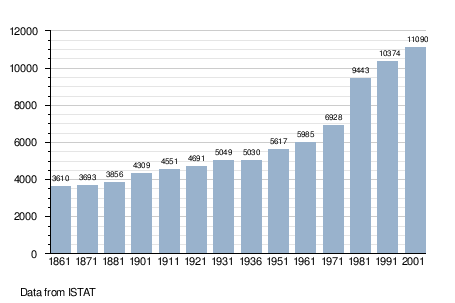Mondolfo
| Mondolfo | |
|---|---|
| Comune | |
| Comune di Mondolfo | |
.svg.png) Mondolfo within the Province of Pesaro-Urbino | |
 Mondolfo Location of Mondolfo in Italy | |
| Coordinates: 43°45′N 13°6′E / 43.750°N 13.100°ECoordinates: 43°45′N 13°6′E / 43.750°N 13.100°E | |
| Country | Italy |
| Region | Marche |
| Province | Pesaro e Urbino (PU) |
| Frazioni | Marotta, Ponterio, Centocroci |
| Area | |
| • Total | 22.7 km2 (8.8 sq mi) |
| Population (Dec. 2004) | |
| • Total | 11,478 |
| • Density | 510/km2 (1,300/sq mi) |
| Time zone | CET (UTC+1) |
| • Summer (DST) | CEST (UTC+2) |
| Postal code | 61037 |
| Dialing code | 0721 |
Mondolfo is a comune (municipality) in the Province of Pesaro e Urbino in the Italian region Marche, located about 35 kilometres (22 mi) northwest of Ancona and about 25 kilometres (16 mi) southeast of Pesaro, on the Adriatic Sea. As of 31 December 2004, it had a population of 11,478 and an area of 22.7 square kilometres (8.8 sq mi).[1]
Geography
The municipality of Mondolfo contains the frazioni (subdivisions, mainly villages and hamlets) Marotta, Ponterio, and Centocroci.
Mondolfo borders the following municipalities: Castel Colonna, Fano, Monterado, San Costanzo, Senigallia.
Mondolfo is located at an elevation of between 0 and 157 metres (515 ft) above sea level. There are 322 companies and 3,533 employees.
History
The magnificent celebrations that Mondolfo offered the Duke of Urbino, Francesco Maria Ist Della Rovere, when he visited it with his court to confer it the title of “Terra Fedelissima” or loyal land, are recalled every year in July, with the historical remembrance of Contrade in Festa. The events, that happened in 1523, evoke some of the most heroic and glorious pages of the borough of Mondolfo when, in spite of the bad fortune of the Della Rovere family, it remained loyal to Francesco Maria Ist Della Rovere and fought valiantly at his side, until it surrendered to a mighty siege, “coming to terms” only after having seriously wounded the one who Duke Della Rovere deposed. In 1517, Pope Leo X, a member of the Medici family, declared that Francesco Maria’s rule was no longer in force of the dukedom of Urbino because of his betrayal, and assigned it to his nephew Lorenzo De Medici, or Lorenzino as he was called, to differentiate him from his grandfather, who was known as “the Magnificent”. The Castle and Fortress of Mondolfo didn’t open the doors to the new lord: too strong was the loyalty and the link with Francesco Maria who, when he was a child, stayed there for a long time owing to the mildness of its climate. During that spring of 1517 Mondolfo suffered an historical siege, told by Guicciardini who personally lived those events, heroically withstanding the Medicean troops, seriously wounding Lorenzino in the head and surrendering only when there was no hope, suffering a vile and treacherous pillage. When Francesco Maria Ist Della Rovere, as often happened in the alternate fortune of the Italian Renaissance princes, regained the dukedom of Urbino, he didn’t forget Mondolfo’s loyalty and conferred it the title of “Terra Fedelissima”. Those were days of wonderful joyful times, with the ducal court being received as a guest of Mondolfo’s Castle, enclosed with its double boundary walls, and entertained with sporting events, chivalrous jousting and tourneys, a medieval ball game called “bracciale”, musicians, warriors, flag wavers, acrobats and jugglers. The four “contrade” of the Land of Mondolfo – Castello, Piana, Barriera and Fosso – symbolically handed the Duke the keys of the Town, the Magistrates renewed the act of loyalty, obtaining from Francesco Maria the ducal crown to decorate the municipal coat of arms, as a sign of everlasting favour and inseparable friendship with the Della Rovere family.
Demographic evolution

Points of interest
- Chiesa di Sant'Agostino (1586–93)
- Convento di Sant'Agostino (XVII secolo)
- Chiesa di Santa Giustina (1760 circa) C
- Chiesa di San Giovanni (XVII secolo)
- Palazzo Giraldi Della Rovere (XVI secolo)
- Palazzo Peruzzi (XVI secolo)
- Parco della Rimembranza e monumento (1925) Belvedere
- Fonte Grande (XX secolo)
- Memoria della Fisarmonica
- Chiesa e Chiostro di San Sebastiano (1738–60)
- Chiesa di San Gervasio (V-VI secolo)
- Santuario della Madonna Delle Grotte (1682)
- Bastione Sant'Anna e Giardino Martiniano (XVI secolo)
References
External links
![]() Media related to Mondolfo at Wikimedia Commons
Media related to Mondolfo at Wikimedia Commons